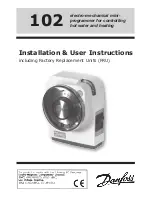
6K V1.02 03-16-91
16
6.
REPEATER CTCSS DECODER
CTCSS, or Continuous Tone-Controlled Squelch System, is a convenient problem solver for users
and owners in many parts of the country where the bands are overcrowded with repeaters and RFI.
In addition, your controller allows CTCSS to be required as a qualifier for entering DTMF
commands, thus increasing the security of the repeater system.
Well-known trademarked names for CTCSS include "PL" and "Private Line" (Motorola), "Channel
Guard" (General Electric), and "Call Guard" (Johnson). Your repeater may already have a CTCSS
decoder built in, or you may wish to install one of the add-on boards readily available from a
number of sources. A good example is the TS-32P from Communications Specialists, Inc., of
Orange, CA (telephone 1-800-854-0547). The TS-32P is crystal-controlled for stability, and allows
dipswitch selection of one of 32 CTCSS tone frequencies.
The CTCSS decoder should be installed in your repeater receiver following the instructions
provided by the decoder manufacturer. You will need to connect the decoder's audio input directly
to the receiver's discriminator output. The decoder provides a logic output, usually an open-
collector transistor driver, which goes either "low" or "high" upon detection of CTCSS. This signal
should be connected to pin 4 of the controller's J2 connector.
The controller's CTCSS Decoder input circuitry is designed exactly like the RX1 COR input. The
transistor in this case is Q2A, the voltage divider is made up of R11B and the resistor on pin 4 of
R12, and the pullup resistor is R15. You may wish to refer back to the "RECEIVER #1 COR"
section of this manual for a discussion of the hardware design of the input circuit.
To check your CTCSS decoder interface, power up your receiver, CTCSS decoder, and the
controller. Measure the voltage at pin 4 of J2. This voltage must swing above the 2.1 V threshold
as the incoming CTCSS tone is applied and removed.
You must also determine the "sense" of your CTCSS decoder output. Does the output go "low" or
"high" when the correct CTCSS tone is received? If the output goes "low" when the tone is
detected and returns "high" when the tone is removed, then place dip switch #3 (part of S2) in the
ON (closed) position. If, however, the output goes "high" when the tone is detected and returns
"Low" when the tone is removed, then place dip switch #3 in the OFF (open) position.
















































